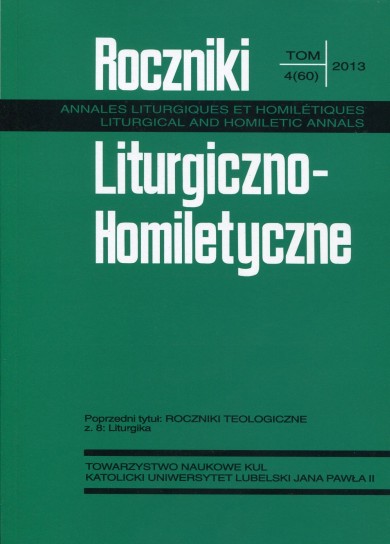Monastic Profession according to the 12th-Century Pontifical of Płock and Its Sources in 10th-Century Romano-Germanic Pontifical
Monastic Profession according to the 12th-Century Pontifical of Płock and Its Sources in 10th-Century Romano-Germanic Pontifical
Author(s): Waldemar PałęckiSubject(s): Christian Theology and Religion
Published by: Katolicki Uniwersytet Lubelski Jana Pawła II - Wydział Teologii
Keywords: monastic profession; pontifical; medieval liturgy; history of the liturgy in Poland
Summary/Abstract: The rite of religious profession in the tradition of the Latin Church has changed through ages, developing rich liturgical forms that served to highlight the importance of the act of initiation of new members into the monastic community. One of the oldest testimonies of this rite in the Latin Church is the Rule of St. Benedict, which predicts that the vows be made in the oratorium. Since the Middle Ages, it has been assumed that the vows be accompanied by a Holy Mass celebrated by the abbot. Since the 10th century, the rite of monastic profession became more regular, thanks to the pontificals, which contained the relevant guidelines for the ceremony. The oldest pattern was the Romano-German Pontifical from St. Alban’s Abbey in Mainz. In a parallel way, one of the oldest liturgical book used as a pattern in the territories of the historical Polish state is the 12th-century Pontifical of Płock. Detailed research of this book, conducted by Rev. Antoni Podleś, revealed that it constitutes is a specific variety of the older Romano-German Pontifical. The rite of monastic profession presented in the 12th-century Pontifical of Płock can count among the oldest celebrations of the initiation into monastic life. Two rites are included in the book. The historical relation to the 10th-century Pontifical is specially exhibited by the latter of the rites—also present in the Romano-German version. The former celebration in the Pontifical of Pock is richer in gestures and symbols. The liturgical texts emphasise the fact that monastic profession is treated as second baptism. As for the outcomes of the vows, it was also stated that they effect absolution in the same way as baptism does. In the theological outlook, the profession was presented as a sacrifice of one’s life to God. The decision to enter monastic life was motivated by the person's desire for perfection. During the celebration, the abbot recited the texts through which he reminded the candidates of the features and virtues which each votary should display throughout his monastic life. The rite of monastic profession presented in the Pontifical of Płock allows insight into the rich Medieval liturgy and theology of monastic life, while the historical approach to the issue enables better comprehension of contemporary monastic tradition preserved in the Church throughout ages.
Journal: Roczniki Liturgiczno-Homiletyczne
- Issue Year: 2013
- Issue No: 4 (60)
- Page Range: 151-172
- Page Count: 22

